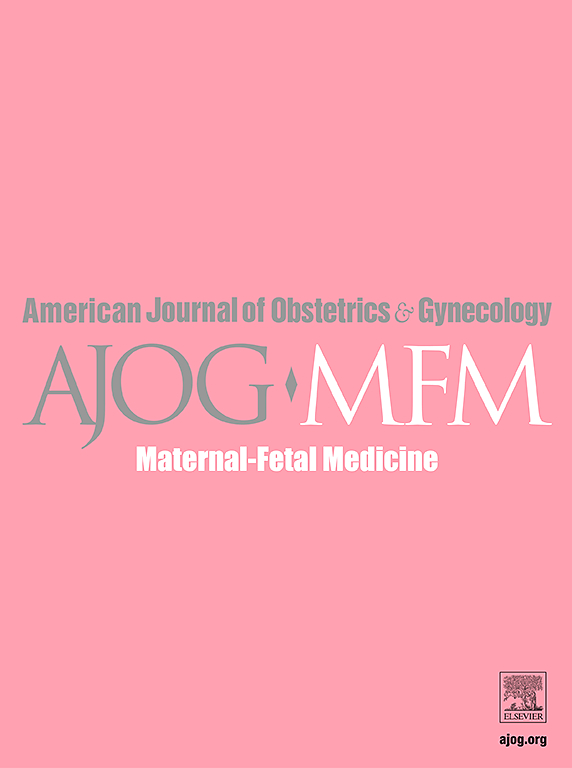Antenatal corticosteroids for patients at risk of late preterm birth: a systematic review and meta-analysis of randomized controlled trials
IF 3.1
2区 医学
Q1 OBSTETRICS & GYNECOLOGY
American Journal of Obstetrics & Gynecology Mfm
Pub Date : 2025-05-24
DOI:10.1016/j.ajogmf.2025.101709
引用次数: 0
Abstract
Objective
To evaluate the effectiveness of antenatal corticosteroid administration in the late preterm period (34 0/7–36 6/7 weeks of gestation).
Data Sources
A Medical Librarian performed a search in the following databases and grey literature sources from inception until July 15, 2024: PubMed (NLM), Embase.com (Elsevier), Scopus (Elsevier), Cochrane CENTRAL (Wiley), CINAHL Ultimate (EBSCOHost), ClinicalTrials.gov and WHO ICTRP.
Eligibility criteria for selecting studies
This study screened studies using 2 independent reviewers based on the predefined inclusion/exclusions criteria. This study included randomized controlled trials (RCTs) comparing antenatal corticosteroid administration with placebo or with no treatment given to individuals with singleton gestations at 34 0/7–36 6/7 weeks.
Study appraisal and synthesis methods
This study appraised the included randomized controlled trials using 2 independent reviewers based on the Cochrane RoB 2 tool and other assessment measures. The primary outcome was the incidence of respiratory distress syndrome (RDS) (6 trials, 5163 newborns). Secondary outcomes included hypoglycemia (as defined by each trial) (4 trials, 4750 newborns), incidence of transient tachypnea of the newborn (TTN) (4 trials, 4292 newborns), neonatal intensive care unit (NICU) admission (6 trials, 5169 newborns), continuous positive airway pressure (CPAP) use for ≥2 hours (4 trials, 4760 newborns), surfactant administration (2 trials, 3100 newborns), neonatal sepsis (4 trials, 4754 newborns), neonatal mortality (5 trials, 4920 newborns), need for resuscitation in the labor suite (4 trials, 4647 newborns), hyperbilirubinemia (2 trials, 1156 newborns), necrotizing enterocolitis (NEC) (2 trials, 3710 newborns), mechanical ventilation (5 trials, 5069 newborns) and Apgar Score at 5 minutes of life (2 trials) and maternal outcomes. The summary measures were reported as relative risk (RR) or as mean difference (MD) with 95% of confidence interval (CI) using the random effects model of DerSimonian and Laird. I-squared(Higgins I2) greater than 0% was used to identify heterogeneity.
Results
Six RCTs, encompassing 5143 deliveries, were included for analysis. The incidence of RDS was similar in the 2 groups (RR 0.89, 95% CI 0.68–1.16), as was the rate of transient tachypnea of the newborn (TTN) (RR 0.93, 95% CI 0.67–1.29). Antenatal corticosteroids significantly reduced the use of CPAP ≥2 hours (RR 0.78, 95% CI 0.65–0.94; P=.007) and surfactant (RR 0.61, 95% CI 0.38-0.99; P=.04) compared to the control. There were no significant differences in mechanical ventilation (RR 0.75, 95% CI 0.51–1.11), NICU admission rate (RR 0.92, 95% CI 0.82–1.03), hypoglycemia (RR 1.28 95% CI 0.93–1.74) neonatal death (RR 0.94, 95% CI 0.34–2.63), Apgar Score at 5 min (MD 0.07 95% CI 95% –0.03, 0.17) between the 2 groups. The need for resuscitation, incidence of neonatal sepsis, hyperbilirubinemia, neonatal enterocolitis, cesarean delivery, chorioamnionitis, fever and postpartum endometritis were also similar between the 2 groups.
Conclusions
Antenatal corticosteroids administered between 34 0/7–36 6/7 weeks of gestation in patients at risk of preterm birth do not reduce RDS but reduce the use of CPAP for more than 2 hours and surfactant.
Systematic review registration
CRD42024548167.
晚期早产风险患者的产前皮质类固醇:随机对照试验的系统回顾和荟萃分析。
目的:评价早产儿晚期(妊娠34 0/7 ~ 36 6/7周)使用皮质类固醇的有效性。数据来源:一位医学图书管理员对以下数据库和灰色文献来源进行了搜索,从开始到2024年7月15日:PubMed (NLM)、Embase.com (Elsevier)、Scopus (Elsevier)、Cochrane CENTRAL (Wiley)、CINAHL Ultimate (EBSCOHost)、ClinicalTrials.gov和WHO ICTRP。研究的入选标准:本研究根据预定义的纳入/排除标准,由两名独立的审稿人对研究进行筛选。本研究包括随机对照试验(rct),比较在34 0/7 - 36 6/7周单胎妊娠的个体在产前给予皮质类固醇与安慰剂或不给予治疗。研究评价和综合方法:本研究采用两名独立评论者基于Cochrane RoB 2工具及其他评价指标对纳入的随机对照试验进行评价。主要终点是呼吸窘迫综合征(RDS)的发生率(6项试验,5163名新生儿)。次要结局包括低血糖(根据每个试验的定义)(4项试验,4750名新生儿)、新生儿一过性呼吸急促(TTN)的发生率(4项试验,4292名新生儿)、新生儿重症监护病房(NICU)入院(6项试验,5169名新生儿)、持续气道正压通气(CPAP)使用≥2小时(4项试验,4760名新生儿)、表面活性剂给药(2项试验,3100名新生儿)、新生儿败血症(4项试验,4754名新生儿)、新生儿死亡率(5项试验,4920名新生儿)。产房复苏需求(4项试验,4647名新生儿)、高胆红素血症(2项试验,1156名新生儿)、坏死性小肠结肠炎(2项试验,3710名新生儿)、机械通气(5项试验,5069名新生儿)、生命5分钟时的Apgar评分(2项试验)和孕产妇结局。使用DerSimonian和Laird的随机效应模型,以相对危险度(RR)或95%置信区间(CI)的平均差(MD)报告汇总测量结果。使用大于0%的i²(Higgins I2)来识别异质性。结果:6项随机对照试验,包括5143例分娩,纳入分析。两组RDS发生率相似(RR 1.03, 95% CI 0.73-1.45),新生儿短暂性呼吸急促(TTN)发生率相似(RR 0.93, 95% CI 0.67-1.29)。产前皮质类固醇显著降低≥2小时CPAP的使用(RR 0.78, 95% CI 0.65-0.94;p= 0.007)和表面活性剂(RR 0.61, 95% CI 0.38-0.99;P = 0.04)。两组在机械通气(RR = 0.75, 95% CI 0.51-1.11)、NICU入院率(RR = 0.94, 95% CI 0.84-1.05)、低血糖(RR = 1.28, 95% CI 0.93-1.74)、新生儿死亡(RR = 0.94, 95% CI 0.34-2.63)、5 min Apgar评分(MD = -0.07, 95% CI 95% -0.17-0.03)方面比较差异均无统计学意义。两组的复苏需求、新生儿败血症、高胆红素血症、新生儿小肠结肠炎、剖宫产、绒毛膜羊膜炎、发热、产后子宫内膜炎发生率也相似。结论:有早产风险的患者在妊娠34 0/7 ~ 36 6/7周期间给予皮质类固醇不会降低RDS,但会减少CPAP使用时间超过2小时和表面活性剂的使用。
本文章由计算机程序翻译,如有差异,请以英文原文为准。
求助全文
约1分钟内获得全文
求助全文
来源期刊

American Journal of Obstetrics & Gynecology Mfm
Medicine-Medicine (all)
CiteScore
7.40
自引率
3.20%
发文量
254
审稿时长
40 days
期刊介绍:
The American Journal of Obstetrics and Gynecology (AJOG) is a highly esteemed publication with two companion titles. One of these is the American Journal of Obstetrics and Gynecology Maternal-Fetal Medicine (AJOG MFM), which is dedicated to the latest research in the field of maternal-fetal medicine, specifically concerning high-risk pregnancies. The journal encompasses a wide range of topics, including:
Maternal Complications: It addresses significant studies that have the potential to change clinical practice regarding complications faced by pregnant women.
Fetal Complications: The journal covers prenatal diagnosis, ultrasound, and genetic issues related to the fetus, providing insights into the management and care of fetal health.
Prenatal Care: It discusses the best practices in prenatal care to ensure the health and well-being of both the mother and the unborn child.
Intrapartum Care: It provides guidance on the care provided during the childbirth process, which is critical for the safety of both mother and baby.
Postpartum Issues: The journal also tackles issues that arise after childbirth, focusing on the postpartum period and its implications for maternal health. AJOG MFM serves as a reliable forum for peer-reviewed research, with a preference for randomized trials and meta-analyses. The goal is to equip researchers and clinicians with the most current information and evidence-based strategies to effectively manage high-risk pregnancies and to provide the best possible care for mothers and their unborn children.
 求助内容:
求助内容: 应助结果提醒方式:
应助结果提醒方式:


